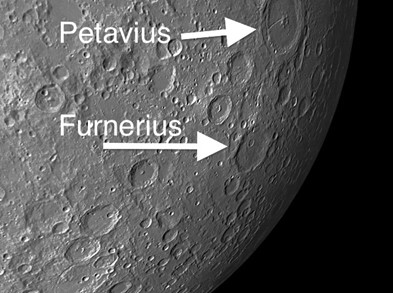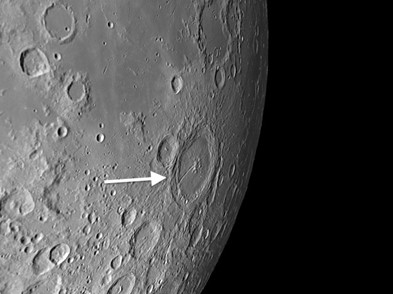 The week of July 25-31 takes us from Day 27 to Day 3. This week we will highlight a series of craters called the Great Eastern Chain.
The week of July 25-31 takes us from Day 27 to Day 3. This week we will highlight a series of craters called the Great Eastern Chain.
The Great Eastern Chain: [SE/K-N16; L=61°E] There is a conspicuous chain of large craters, at one time referred to as the Great Western Chain, which closely hugs the same meridian near the eastern limb (i.e., the rim of the visible disk) of the Moon. They start on the southeastern shore of the Sea of Fertility and continue south1. The chain consists of Langrenus, Vendelinus, Petavius, and Furnerius. These craters started to come into view last night. Although this unusual alignment is coincidental, it was once posited as evidence to support the endogenic theory of crater formation–the now disproven theory that the majority of craters were formed by volcanic forces originating from within the Moon. (Come back on Day 17 when you’ll be able to see them more clearly.)
Langrenus & Vendelinus: [SE/K-L16; L=61°E] These craters are the first two segments of the Great Eastern Chain. Langrenus and Vendelinus are two large 90-mi. craters located on the southeast shore of Fertility. One is considerably older than the other and appeared before the lava flows started. It should be easy for you to decide which is which2.
The terraces and central peaks of Langrenus will have emerged from last night’s shadows, and tonight the crater is a beautiful sight. Even if you have a small telescope, there is much detail in the interior and on the outer ramparts to keep you busy. Because the appearance of the crater changes significantly with different lighting angles, make some drawings of what it looks like tonight and come back over the next few nights to compare the views.
The younger crater Lamé intrudes on Vendelinus on its NE rim, and it is appropriately smaller. However, notice that Lamé, in turn, overlaps two smaller unnamed craters on its S.W. rim. This is unusual in that intruding craters are almost always smaller than the craters they impact on.
 Furnerius: [SE/N16; L=61°E] This is the last of the craters that make up the Great Eastern Chain and it is very old, having formed before the impact that created the Nectaris basin 3.9 billion years ago. Although the walls have been battered down and show their age, there are still many complexities remaining which will reward careful observation. There are several craterlets of varying sizes on the floor of Furnerius, including a 30-mile rille extending from the north rim toward the southeast. Patrick Moore reports that there are fourteen large craters and several craterlets in its interior. (A more reasonable assessment would be there is one large crater and several craterlets.) Make a rough sketch of how many you can see, then come back next month to see if you can add to the count. Can you match Patrick Moore’s observing skills?
Furnerius: [SE/N16; L=61°E] This is the last of the craters that make up the Great Eastern Chain and it is very old, having formed before the impact that created the Nectaris basin 3.9 billion years ago. Although the walls have been battered down and show their age, there are still many complexities remaining which will reward careful observation. There are several craterlets of varying sizes on the floor of Furnerius, including a 30-mile rille extending from the north rim toward the southeast. Patrick Moore reports that there are fourteen large craters and several craterlets in its interior. (A more reasonable assessment would be there is one large crater and several craterlets.) Make a rough sketch of how many you can see, then come back next month to see if you can add to the count. Can you match Patrick Moore’s observing skills?
Petavius: [SE/M16; L=60°E] This is one of the most fascinating craters on the Moon. It is an example of a floor-fractured crater (FFC), a type of crater that has been modified by later volcanism, uplift, and consequent fracturing. The floor of Petavius is nearly 1,000 feet higher near its center than around the edge! Is the curvature of the lunar surface apparent on its floor? Turbulence and volcanic upheaval from below split the central mountain (which rises to nearly one mile above the floor) and formed the rilles.
 The principal rille, Rima Petavius, is so prominent that it can be seen with a 60mm refractor. It is a graben, an elongated depression that results when stresses open up two parallel cracks in the lunar crust and the terrain in between drops. The rille extends from the central peak to the southwest wall. There is actually a system of rilles on the floor. How many can you see with your instrument?
The principal rille, Rima Petavius, is so prominent that it can be seen with a 60mm refractor. It is a graben, an elongated depression that results when stresses open up two parallel cracks in the lunar crust and the terrain in between drops. The rille extends from the central peak to the southwest wall. There is actually a system of rilles on the floor. How many can you see with your instrument?
1 Its official (and somewhat cumbersome) name is Mare Fecunditatis. I prefer the simplicity of “Fertility.”
2 Because it is so heavily worn and has had time to acquire many overlapping smaller craters, Vendelinus is the older.
======================
It is highly recommended that you get a copy of Sky and Telescope’s Field Map of the Moon, the very finest Moon map available for use at the telescope. It is available for $10.95 at www.skyandtelescope.com and on Amazon. All features mentioned in this blog will be keyed to the grid on the Field Map and will look like this: Plato: [NW/D9]
Credits:
Courtesy of Gray Photography of Corpus Christi, Texas
Lunar photos: NASA / USGS / BMDO / LROC / ASU / DLR / LOLA / Moon Globe. Used by permission
- Rupes Cauchy: A Best Known Fault on the Moon - July 22, 2024
- Moon Crater Schickard – Crater Floor has Stripes - July 15, 2024
- Moon Craters Langrenus and Vandelinus - July 8, 2024